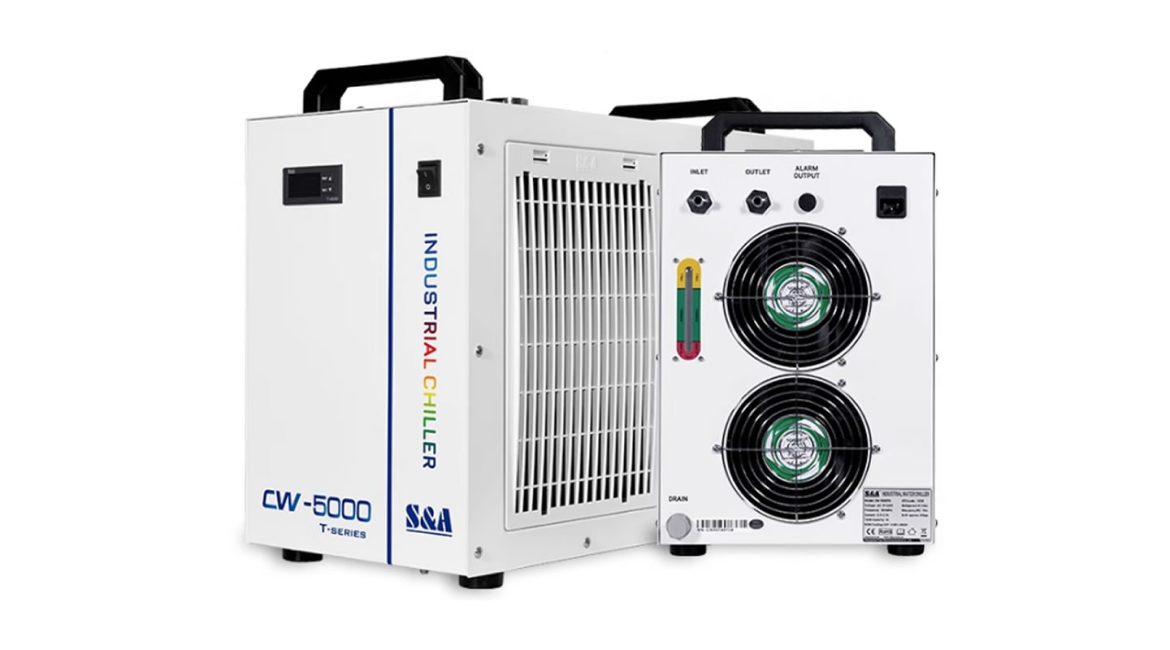For RF-excited CO2 lasers (typically metal or ceramic tubes), stable performance and long lifespan are crucial. Indeed, these depend significantly on a high-precision thermal management system. Specifically, this system is a water chiller system. Many people believe water cooling just prevents overheating. However, this water chiller system’s function runs deeper. More precisely, it ensures the laser cavity achieves thermal equilibrium. Furthermore, it maintains optimal operating conditions. Therefore, understanding this water chiller system’s complex role is vital.
I. More Than Just Cooling: Key to Maintaining Cavity Thermal Balance
During operation, RF lasers convert only a small part of input electrical energy into laser light. Instead, most energy, typically over 80%, dissipates as heat. This heat concentrates within the laser cavity and on the electrodes. Consequently, if the water chiller system fails to remove this heat efficiently. Moreover, if removal is not uniform, two critical issues arise.
1.Material Thermal Stress: Uneven temperatures cause expansion and deformation in metal or ceramic cavities. Indeed, these minute changes directly impact the optical resonant cavity structure. For instance, reflector and output coupler positions shift. As a result, this degrades beam quality. Additionally, it causes beam path drift.
2.Gas Parameter Imbalance: Uncontrolled internal gas temperature affects gas density. Furthermore, it impacts particle excitation efficiency and relaxation rates. Ultimately, this directly causes laser power fluctuations. Likewise, it leads to decay.
To elaborate, a water chiller system precisely and rapidly removes excess heat. It uses high-velocity cooling water flowing through the laser cavity’s cooling channels. In this way, it achieves overall thermal equilibrium for the laser. The water chiller system ensures core components maintain a preset optimal constant temperature. This happens at any power level. Consequently, it preserves optical cavity geometric stability. Hence, this water chiller system is fundamental to power stability.
II. Flow Rate and Temperature Control Precision: Two Core Performance Parameters
A water chiller system’s efficiency is not merely about water flow. Rather, its flow rate, velocity, and temperature control precision are critical determinants of laser performance. Let’s examine these factors for the water chiller system.
· Flow Rate and Velocity: Adequate flow rate and velocity are crucial for efficient heat removal. Conversely, insufficient flow causes rapid temperature increases in the cooling water. This creates large temperature differences across the cavity. Subsequently, it leads to uneven cooling. As a result, it affects the laser beam’s mode. Furthermore, it impacts stability. Therefore, the water chiller’s pump power and water path cleanliness require strict assurance.
· Water Temperature Control Precision: This is the “invisible” core for ensuring power stability. High-performance RF lasers demand water temperature control within very tight ranges. For example, they often require ±0.1°C or ±0.5°C. Any water temperature fluctuation alters the cavity temperature. Gas density and characteristics change accordingly. Consequently, this causes laser output power to drift. A high-precision temperature control system—typically a professional PID-controlled water chiller—effectively counteracts environmental temperature changes. Ultimately, it locks the laser into its optimal gas density. Moreover, it maintains the best discharge state.
III. Choosing a Cooling Medium: The Importance of Pure/Deionized Water
Choosing a cooling medium appears simple. However, its choice is crucial for the long-term safety of the laser and its water chiller system. Professional-grade lasers typically require deionized or high-purity water. Conversely, using untreated tap water or common mineral water is strictly prohibited. This is because of several reasons.
1.Anti-Electrochemical Corrosion and Scaling: Tap water or common water contains numerous minerals and ions. Furthermore, in the high-voltage, high-frequency laser cavity environment, these ions easily cause electrochemical corrosion. This accelerates damage to metal cavities. Additionally, it harms water path components. Moreover, scale accumulates on cooling channel inner walls. This causes blockages. Furthermore, it leads to a sharp drop in local cooling efficiency. Ultimately, the laser fails due to overheating. A properly maintained water chiller system prevents this.
2.Preventing Contamination of Optical Components: Tiny impurities in the cooling system, if they enter the laser head, can contaminate expensive focusing lenses or reflectors. Consequently, they absorb laser energy. This results in damage to the optics. Indeed, deionized water largely eliminates these risks. The water chiller system must use pure water.
Summary:
In summary, an RF laser’s water chiller system is far from a mere accessory. Instead, it forms the cornerstone for achieving high power. Furthermore, it ensures excellent beam quality and a long lifespan. Through precise control of water temperature, flow, and cooling medium, it successfully maintains the laser cavity’s thermal stability. Additionally, it ensures optimal gas parameters. Ultimately, this water chiller system acts as the ‘unsung hero’ ensuring stable laser power output.

